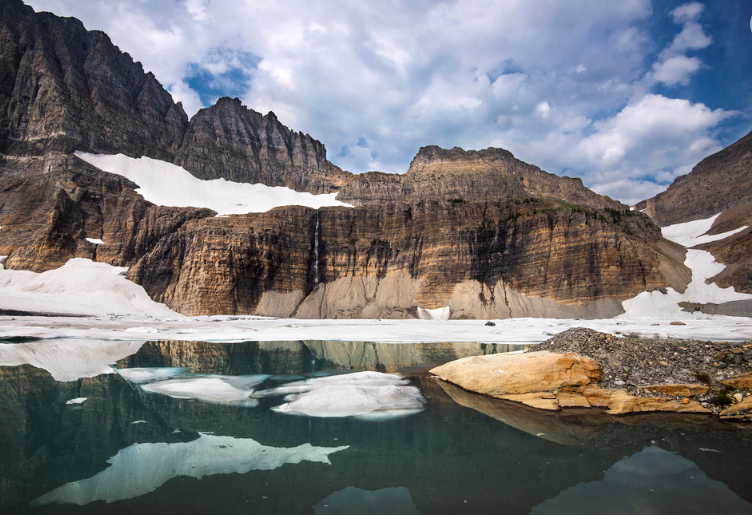
Majestic.
Awe-inspiring.
Magnificent.
Grand.
Stunning.
Imposing.
Lofty.
Monumental.
These are just a few descriptive words that come to mind after seeing this beautiful American treasure in person. Seeing Glacier National Park has long been on my bucket list. As reports of shrinking glaciers due to climate change and western wildfires increased, so did my desire to see it for myself. In 1850, there were 150 active glaciers in the area comprising the park; as of 2015, the park service reported there were about 26 large enough to still be considered active glaciers. A glacier is a slowly moving mass or river of ice formed by the accumulation and compaction of snow on mountains or near the poles. What makes a glacier active is that it is still acquiring snow and moving.
My husband Wes and I set out on a driving trip last summer with three purposes in mind: 1) escape the Texas heat; 2) visit the remaining five states of the U.S. to complete my bucket list item of visiting all 50; and 3) see Glacier National Park while we could.
GNP was established as a National Park in 1910. It is a land of mountain ranges carved by prehistoric ice rivers. Along with the glaciers, it features alpine meadows, deep forests, waterfalls, and about 200 sparkling lakes. Called the “Crown of the Continent” and located in northwest Montana, the park is one of the northernmost national parks in the United States. If you choose to drive, you can plan for around 23-25 hours, but be sure to check schedules and roads–because many are closed from September to May.
After spending the night in Great Falls, Montana, we headed northwest toward the Blackfeet Indian Reservation. Driving across the plains, you begin to see the snowcapped peaks in the distance. I am unsure how many miles we traveled as the mountains loomed larger and larger, with me thinking we would arrive “any minute now.” While driving, we did agree that “Big Sky Country” is appropriately named, but we are still trying to figure out why the sky seems so much wider and closer than in Texas, even west Texas.
We made a brief stop in East Glacier Park Village at the World Famous Whistle Stop Restaurant for lunch and were introduced to their award-winning huckleberry pie. Our entire travel plan consisted of “GO and SEE,” so we were a little unprepared as to what to expect and how best to see and enter the park. As a meticulous planner, this “fly by the seat of your pants” trip was a little out of my comfort zone, and as with most things, there were good and bad aspects to that plan. It was fun to have no set schedule, but we did miss out on a few things that required reservations or better planning. (Next time, I’ll let my meticulous side rule.)
From East Glacier Village, we headed north along the shores of Lower Lake Mary up to Many Glacier, located in an area described the “Switzerland of North America.” This was one of our favorites stops and was home to the Many Glacier Hotel. The hotel was built by the Great Northern Railway in 1914-15 and is beautifully situated on the shores of Swiftcurrent Lake inside Glacier National Park. Standing over the bridge, where water flowing from the lake forms rapids as it travels down one of the many creeks, was mesmerizing. I could have stayed there for hours listening to the water and enjoying the beauty around me.
Our plan was to cross the park via the Going-to-the-Sun Road, but even though it was early July, the road was still closed at Logan Pass (a 6,646-foot-high place where you cross the Continental Divide) due to late snowfall and avalanche danger. We had been told the vistas seen from the Going-to-the-Sun Road are breathtaking and a photographer’s paradise. Alas, that will have to be saved for the next trip. We were able to go far enough on the road to get to the Jackson Glacier overlook, which was awesome. The Going-to-the-Sun Road is a winding road that provides many pullouts for sightseeing and photographic opportunities. An engineering feat and National Historic Landmark, the Going-to-the-Sun Road was completed in 1932 after 11 years of construction. It is considered to be one of the most scenic roads in North America.
One thing you should keep in mind is that, effective this year, vehicle reservations are required for four areas of the park: Going-to-the-Sun Road, the North Fork, Two Medicine, and Many Glacier. Each location has unique details and requires a separate reservation. Vehicle reservations are available in advance online at Recreation.gov, the Recreation.gov app, or the Recreation.gov Call Center (Reservation Line: 877-444-6777). They are not available for purchase at the park.
Traveling around the south end of the park (instead of through it) took much longer, but we enjoyed some unexpected sights as we crossed the Continental Divide, which included the Theodore Roosevelt Memorial Monument. Resembling the Washington Monument, the memorial is a 60-foot-tall granite obelisk constructed in 1931. There was also a memorial statue to John F. Stevens, who was tasked with locating a suitable pass for the Great Northern Railroad to use across the Divide. Of course, since my maiden name is Stevens, I told Wes he must have been an ancestor of mine!
We spent the next couple of days on the western side of the park, enjoying the towns of Whitefish and Kalispel, as well as the Lake McDonald area of the park. All in all, we actually ended up enjoying the east side of the park the most, and had the Going-to-the-Sun Road been open (and we had a reservation), we might have gone back to spend more time there. Seeing wildlife was a perk of the entire experience, but one of our favorites will always be the amazing moment two bears chose to cross the road right in front of us – and we were well out of the park.
One thing that was a surprise to us is that relatively few miles of road exist in the park’s 1,600 square miles of picturesque landscape, thus preserving its primitive and unspoiled beauty. You can certainly see a lot by car, but while Going-to-the-Sun Road may be the quickest way to see Glacier National Park, there are numerous hiking trails throughout the park, providing exclusive views that can only be seen by foot. The hiking choices are numerous; the trail can be determined by difficulty, length, or landmark. There are several trailheads that can be found off the Going-to-the-Sun Road, or you can take a boat to get to more secluded trailheads.
Here are a few helpful things to remember if you are planning to visit:
Travel times to consider when planning your trip:
Glaciers store about 70% of the world’s freshwater. They regulate stream temperatures and maintain stream flow during late summer and drought periods when other sources are depleted. Without glacial meltwater, summer water temperatures will increase and may stress temperature sensitive species, such as aquatic insects and native trout.
The United States Geological Survey (USGS) started the Repeat Photography Project in 1997 with a systematic search of Glacier’s archives for historic photographs of glaciers in the park. Historically and today, photographing the glaciers can only occur in a narrow window in late August and early September, after the previous winter’s snow has melted from the ice and before the first snows of autumn. It is only in the late summer season that the glaciers can be clearly seen. We are sharing some of those photos here, but you can see more at www.nps.gov/glac.
Some researchers believe there will not be any glaciers remaining in Glacier National Park by as early as 2030. Plan your trip to Glacier while you can, before the glaciers are gone. I am glad we did.

Postcards Magazine
936-293-1188
PO Box 690
Huntsville, TX 77342
